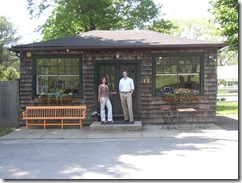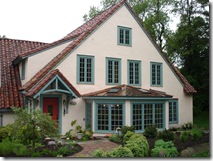Posts in Category: master planning for interiors
Integrated Building Design
When Matt Ulrich and I decided to share an office three years ago, I don’t think we imagined that our teaming up would lead to the current publication of our Connect-the-Dots e-newsletter (along with fellow architect, Juli MacDonald) nor the potential for combined project work. We saw it as a great opportunity to move our home-based businesses into an office space where we each would gain valuable “curbside” exposure with our location on a main street in the community. We had spoken about how beneficial it would be to pass referrals to each other through our client bases, but our main goal was to grow our businesses.
Three years later, not only have we grown our businesses, but we have also had the pleasure to work together on a major kitchen renovation that incorporated Integrated Design principles. At the time, my thought was to bring a team of trusted building trades together to provide great service for my client. I assumed that task as part of my project management responsibilities. I hadn’t realized there was a term other than working in collaboration to tie us all together.
Integrated Building Design Residential Project
I had been working for several years with a client on various rooms within their home; formal dining room, living room, master bedroom/bathroom, various guest and children’s bedrooms and bathrooms, so I was very excited when they said they were ready to renovate their kitchen. Not only to redesign the space, but they wanted to incorporate green design building principles, practices, materials and interior finishes. I had asked if I could introduce them to several professionals that I knew that would be able to design and construct this project. They agreed to meet with the various disciplines.
I introduced them to:
- Matt Ulrich of Matthew Ulrich Landscape Design
- Juli MacDonald of Greenbridge Architects
- Dave West of Meadowview Construction
Along with myself, Lisa Kawski of lmk interiors, ltd., we formed the the design and construction team. We began working as an integrated group from the onset of the project.
You may be wondering what the difference is between Integrated Building Design and the more traditional design process. Let me first define my views of the traditional design process and follow with Integrated Building Design.
- Client hires an architect to design their renovation. Architect designs the space and may introduce the client to builders, engineers, specialists during the initial design process, or they may not. Eventually a builder gets involved, bringing in their various subcontractors. Space gets built. The client may engage the services of an interior designer to assist them with finish and fixture selections, but often the builder will direct the client to some of their sources for this stage. If the client had initially allocated specific monies, they may hire an interior designer and possibly hire a landscape designer for the exterior. Often, these two professions do not get hired until several years later. Money was not budgeted at the onset of the project to allow for a complete renovation.
- Integrated building design (according to Wikipedia) is “a collaborative method for designing buildings which emphasizes the development of a holistic design.” This is teamwork at its best. Multiple disciplines (architect, interior designer, builder, landscape designer, engineers, etc.) come together in the initial planning stages of design to achieve a cost-effective, resource-efficient and comfortable result for the client. There is no script for the perfect integrated design process, but there are several levels of decision making that must take place at the start of conceptual design, while the design is being refined, during design development, and during construction. Because every design decision produces a multitude of effects, integrated design requires an understanding of the interrelationship of each discipline. It requires all of the participants to think holistically about the project, rather than focus solely on each individual part.
Whether it be new construction or a renovation, approaching the design/build of a building as an interdependent system; where the goal is to make sure that all facets work in harmony rather than against each other, benefit both the client and all of the disciplines involved.
Integrated Building Design, Our Outcome
Out of that project; Matt, Juli and I established Connect-the-Dots. Attending networking events and building trade meetings, we realized we enjoyed working together as well as learning more about sustainable building practices. Our desire to offer clients a one-stop resource to assist them with their design needs would prove beneficial through this pairing. Our mission is: We are a professional collaboration between three friends who share a passion for green design, each from our own perspective: architecture, landscape design and interior design. Our goal is to share useful and up-to-date information on green design, filtered through our distinct, but connected points of view. Through our e-newsletter, which we have been sending out since last May, we connect the subscriber to our individual blogs. We are very excited to announce the launch of our micro website this month: www.ctdcollaborative.com. Please share this web address with those that you think would enjoy it. They can subscribe to receive our e-newsletter on the site.
As always, if you have any questions, please feel free to contact me at (978)335-1140 or [email protected].
Hamilton Wenham Green Presents:
GREEN SPEAKER SERIES
I am a member of the Hamilton Wenham Green Business Group. On March 3rd, Wednesday, at 7 pm I will be presenting Eco-Friendly Interior Finishes: ideas for implementing eco- friendly materials in the redesign of both kitchen and bath.
location: Hamilton Wenham Public Library @ 14 Union Street South Hamilton – (978)468-5577, lectures are free and open to the public, please come.
MASTER PLANNING: an interior designer’s perspective
- “Where do we begin?”
- “We have so many things we want to do, but we are not sure how to go about accomplishing them all.”
- “We want to move forward, but we can only afford to do this room for now.”
This is some of the dialog I hear upon receiving a telephone inquiry or meeting with a client to discuss how I can help them with their interior design needs. Whether the project involves one room or an entire home, planning accordingly is of utmost importance. This allows the client to make informed decisions regarding budget, scheduling, specifying and purchasing.
Where do we begin?
Just like most things in life, having a plan going forward provides parameters that enable one to have a sense of the scale of a project or task. I like to provide my clients with a road map for their needs. At the initial phone call or meeting with a client I learn of what they are seeking to do with their home. Sometimes, through this conversation we discover other areas that they have been thinking of working on, but have pushed aside in light of prioritizing the task they feel is at the forefront. By sharing all of their thoughts, we can not only focus on the space they would like to begin with, but also lay the groundwork for the additional areas for the future. It sometimes makes sense to add these other areas while doing their main thoughts, just because costs may factor in that enable them to get more for their dollar in the end.
We have so many things we want to do, but we are not sure how to go about accomplishing them.
Write a list. Bullets down the side of the page with ALL of the items listed. It begins with:
- Construction: do the changes involve an addition, are we removing or adding walls.
- Will we be selecting light fixtures, flooring, wall finishes, doors, windows or heating system. I try to get a general idea of the next level of detail. Will I need to contact my subcontractors as well.
- Kitchen: cabinets, counter tops, flooring, appliances, lighting, furnishings, backsplashes, window treatments, etc.
- Bathroom: vanity, tub/shower, flooring, fixtures, flooring, wall finishes, tile work, medicine cabinets, lighting, storage space, window treatments, etc.
- Living room, dining room, bedroom or den: wall finishes, flooring, window treatments, upholstered pieces, furnishings, lighting, tables, case goods, bedding, pillows, carpeting/area rugs, artwork, etc.
My responsibility to my client is to help create this list, if they have not already, so that the magnitude of the project is not quite so overwhelming. There may be several decisions to make, but once they can see them in this format, it provides a checklist once the project begins. It also provides the road map to which I referred to earlier.
We want to move forward, but we can only afford to do this room for now.
By creating the master plan for the entire project, it allows the client to budget and prioritize what they can and want to do now but also plan for their future projects. Often times, while working on one area we come across design ideas that can be noted for the next area to be worked on. Whether it’s a fabric to be used for reupholstering a sofa at a later date, a vanity for a bathroom discovered while selecting cabinetry for a kitchen or ordering window blinds for several rooms because they were being offered at a special discount. Being able to view the project as a whole at the onset and then breakdown all of the components, allows the client to have a better grasp of the details involved with creating not only a beautiful space but also a functional one. In the end, master planning for your project can actually help save you money.
For additional questions or thoughts, please contact:
Lisa Kawski at lmk interiors, ltd. or [email protected].
Have wonderful holiday season!






